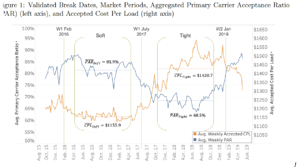Whitepaper: A Quick Read: The Executive’s Guide to OTS (Optimal Transportation Spend)
August 2020
A Quick Read: The Executive’s Guide to OTS (Optimal Transportation Spend)
The Single Source of Truth in Truckload Cost
Executive Summary
Over 70% of TL freight is contracted to primary carriers. Research now shows that shippers are leaving savings on the table by strictly adhering to contracted commitments. Learn how OTS (Optimal Transportation Spend) can provide immediate savings back to shippers.
Through seasonal changes and pandemics, only one thing remains certain in truckload transportation– the uncertainty of capacity. According to an MIT article titled “Elephants or Goldfish?: An Empirical Analysis of Carrier Reciprocity in Dynamic Freight Markets”, a shipper’s key performance indicator is often times their primary carrier’s acceptance ratio, also called PAR.

PAR is defined as the number of loads the carrier accepts compared to the number of loads the carrier won as primary. When a primary carrier’s acceptance rate declines, which is common place in tight markets, shippers leverage non-contracted carriers to move their freight. Using non-contracted carriers usually equates to higher than planned transportation costs which impacts overall business performance. This ebb and flow of carrier availability manifests itself on multiple lines in the P&L, including anything from Cost of Goods Sold (COGS), to revenue per employee, and EBITDA. The uncertain capacity dilemma is one of the biggest triggers to cost overruns within the transportation budget. This brief will examine how a shipper can obtain a single source of truth in truckload transportation cos
Capacity And Cost Implications

Capacity is not only impacted by the elements listed above, it is also impacted by internal processes that are systemic or manual. As the truckload tender process takes place, the average acceptance rate usually sits around 1.6 tenders before a load is accepted. Loads over 125 miles increase dramatically to roughly 2.9 tenders before acceptance (81% increase). As the load moves down the waterfall tender process the cost increases on average 15% for the second carrier and 25% for the third carrier. For example, a load that should have cost $1,000 costs the shipper $1,250. These costs are established in the routing guide; therefore, it is transparent how the cost is derived.
OTS was developed to enhance a shipper’s TMS. As the TMS works through tendering, via the routing guide, OTS dynamically opens up additional capacity and matches loads to carriers that comply with the shipper’s specific load attributes, such as but not limited to: insurance, size of conveyance, drop versus live load, on-time scorecarding, etc.


Privacy Policy | Terms of Service
© 2023 Sleek Fleet, DBA Sleek Technologies. All Rights Reserved.
